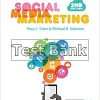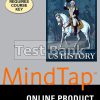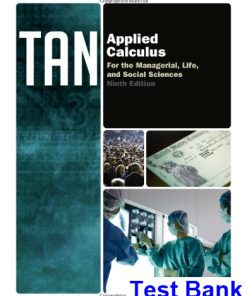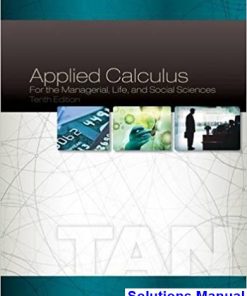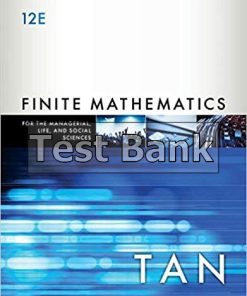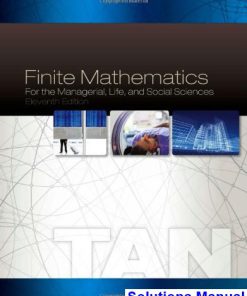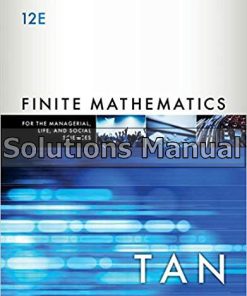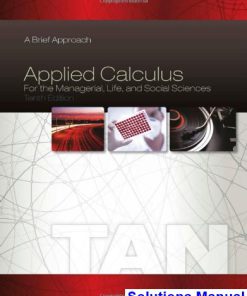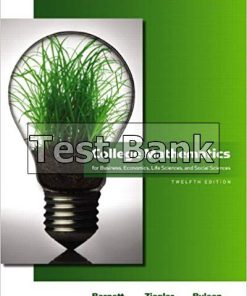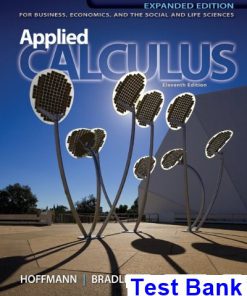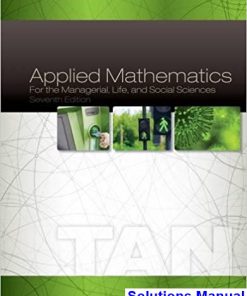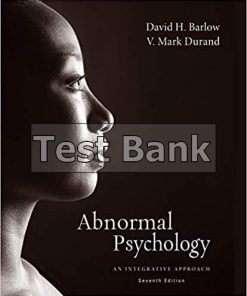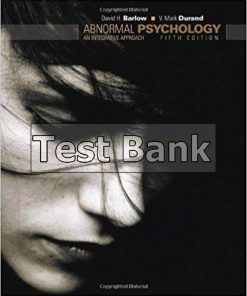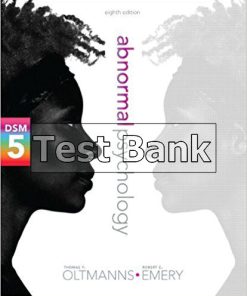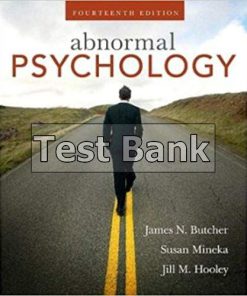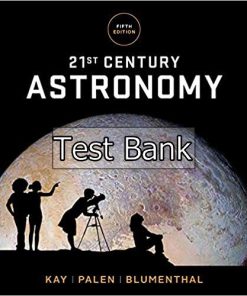Applied Mathematics for the Managerial Life and Social Sciences 6th Edition Tan Test Bank
$50.00 Original price was: $50.00.$26.50Current price is: $26.50.
Applied Mathematics for the Managerial Life and Social Sciences 6th Edition Tan Test Bank.
This is completed downloadable of Applied Mathematics for the Managerial Life and Social Sciences 6th Edition Tan Test Bank
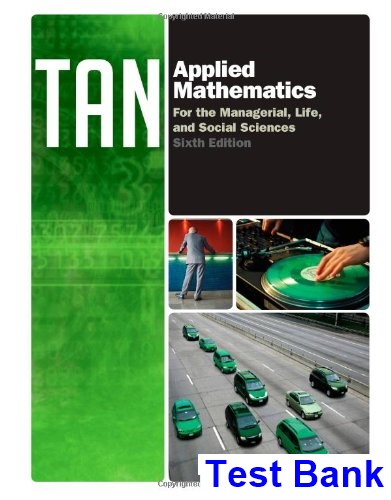
Product Details:
- ISBN-10 : 1133108946
- ISBN-13 : 978-1133108948
- Author: Soo T. Tan
A traditional book with a modern feel, market-leading APPLIED MATHEMATICS FOR THE MANAGERIAL, LIFE, AND SOCIAL SCIENCES, Sixth Edition, teaches by application and uses real-world examples to motivate students. It combines solid theory with innovative technology, includes a robust supplement package, and offers unmatched flexibility that caters to both traditional and modern practitioners. Accessible for majors and non-majors alike, the new Sixth Edition utilizes an intuitive approach that marries real-life instances to what would otherwise be abstract concepts. This is the focus of new and insightful Portfolios, which highlight the careers of real people and discuss how they use math in their professions. Numerous exercises ensure that students have a solid understanding of concepts before advancing to the next topic. By offering a powerful array of supplements such as Enhanced WebAssign, the new Sixth Edition enables students to maximize their study time and succeed in class.
Table of Content:
1. FUNDAMENTALS OF ALGEBRA. Real Numbers.Polynomials.Factoring Polynomials. Rational Expressions. Integral Exponents. Solving Equations. Rational Exponents and Radicals. Quadratic Equations. Inequalities and Absolute Value.Chapter 1 Summary of Principal Formulas and Terms. Chapter 1 Concept Review Questions. Chapter 1 Review Exercises. Chapter 1 Before Moving On.
2. FUNCTIONS AND THEIR GRAPHS. The Cartesian Coordinate System. Equations of Lines. Using Technology: Graphing Straight Lines. Functions and Their Graphs. Using Technology: Graphing a Function. The Algebra of Functions. Linear Functions. Quadratic Functions. Portfolio. Using Technology: Constructing Matehmatical Models from Raw Data. Functions and Mathematical Models. Portfolio. Chapter 1 Summary of Principal Formulas and Terms. Chapter 2 Concept Review Questions. Chapter 2 Review Exercises. Chapter 2 Before Moving On.
3. EXPONENTIAL AND LOGARITHMIC FUNCTIONS. Exponential Functions. Using TEchnology. Logarithmic Functions. Exponential Functions as Mathematical Models. Portfolio. Using Technology: Analyzing Matematical Models.
4. MATHEMATICS OF FINANCE. Compound Interest. Using Technology: Finding the Accumulated Amount of an Investment, the Effective Rate of Interest, and the Present Value of an Investment. Annuities. Using Technology: Finding the Amount of an Annuity. Amortization and Sinking Funds. Using Technology: Amortizing a Loan. Arithmetic and Geometric Progressions. Chapter 4 Summary of Principal Formulas and Terms. Chapter 4 Concept Review Questions. Chapter 4 Review Exercises. Chapter 4 Before Moving On.
5. SYSTEMS OF LINEAR EQUATIONS AND MATRICES. Systems of Linear Equations: An Introduction. Systems of Linear Equations: Unique Solutions. Using Technology: Systems of Linear Equations: Unique Solutions. Systems of Linear Equations: Underdetermined and Overdetermined Systems. Using Technology: Systems of Linear Equations: Underdetermined and Overdetermined Systems. Matrices. Using Technology: Matrix Operations. Multiplication of Matrices. Using Technology: Matrix Multiplication. The Inverse of a Square Matrix. Using Technology: Finding the Inverse of a Square Matrix. Chapter 5 Summary of Principal Formulas and Terms. Chapter 5 Concept Review Questions. Chapter 5 Review Exercises. Chapter 5 Before Moving On.
6. LINEAR PROGRAMMING Graphing Systems of Linear Inequalities in Two Variables. Linear Programming Problems. Graphical Solutions of Linear Programming Problems. The Simplex Method: Standard Maximization Problems. Portfolio. Using Technology: The Simplex Method: Solving Maximization Problems. The Simplex Method: Standard Minimization Problems. Using Technology: The Simplex Method: Solving Minimization Problems. Chapter 6 Summary of Principal Formulas and Terms. Chapter 6 Concept Review Questions. Chapter 6 Review Exercises. Chapter 6 Before Moving On.
7. SETS AND PROBABILITY. Sets and Set Operations. The Number of Elements in a Finite Set. The Multiplication Principle. Permutations and Combinations. Portfolio. Using Technology: Evaluating n!, P (n,r) and C (n,r). Experiments, Sample Spaces, and Events. Definition of Probability. Rules of Probability.Chapter 7 Summary of Principal Formulas and Terms. Chapter 7 Concept Review Questions. Chapter 7 Review Exercises. Chapter 7 Before Moving On.
8. ADDITIONAL TOPICS IN PROBABILITY. Use of Counting Techniques in Probability. Conditional Probability and Independent Events. Bayes’ Theorem. Distributions of Random Variables. Using Technology: Graphing a Histogram. Expected Value. Portfolio. Variance and Standard Deviation. Using Technology: Finding the Mean and Standard Deviation. Chapter 8 Summary of Principal Formulas and Terms. Chapter 8 Concept Review Questions. Chapter 8 Review Exercises. Chapter 8 Before Moving On.
9. THE DERIVATIVE. Limits. Using Technology: Finding the Limit of a Function. One-Sided Limits and Continuity. Using Technology: Finding the Points of Discontinuity of a Function. The Derivative. Using Technology: Graphing a Function and Its Tangent Line. Basic Rules of Differentiation. Using Technology: Finding the Rate of Change of a Function. The Product and Quotient Rules; Higher-Order Derivatives. Using Technology: The Product and Quotient Rules. The Chain Rule. Using Technology: Finding the Derivative of a Composite Function. Differentiation of Exponential and Logarithmic Functions. Using Technology. Marginal Functions in Economics. Chapter 9 Concept Review Questions. Chapter 9 Review Exercises. Chapter 9 Before Moving On.
10. APPLICATIONS OF THE DERIVATIVE. Applications of the First Derivative. Using Technology: Using the First Derivative to Analyze a Function. Applications of the Second Derivative. Using Technology: Finding the Inflection Points of a Function. Curve Sketching. Using Technology: Analyzing the Properties of a Function. Optimization I. Using Technology: Finding the Absolute Extrema of a Function. Optimization II. Chapter 10 Summary of Principal Terms. Chapter 10 Concept Review Questions. Chapter 10 Review Exercises. Chapter 10 Before Moving On.
11. INTEGRATION. Antiderivatives and the Rules of Integration. Integration by Substitution. Area and the Definite Integral. The Fundamental Theorem of Calculus. Portfolio. Using Technology: Evaluating Definite Integrals. Evaluating Definite Integrals. Using Technology: Evaluating Integrals for Piecewise-Defined Functions. Area between Two Curves. Using Technology: Finding the Area between Two Curves. Applications of the Definite Integral to Business and Economics. Using Technology: Business and Economic Applications/Technology Exercises. Chapter 11 Summary of Principal Formulas and Terms. Chapter 11 Concept Review Questions. Chapter 11 Review Exercises. Chapter 11 Before Moving On.
12. CALCULUS OF SEVERAL VARIABLES. Functions of Several Variables. Partial Derivatives. Portfolio. Using Technology: Finding Partial Derivatives at a Given Point. Maxima and Minima of Functions of Several Variables. Chapter 12 Summary of Principal Formulas and Terms. Chapter 12 Concept Review Questions. Chapter 12 Review Exercises. Chapter 12 Before Moving On.
People Also Search:
applied mathematics for the managerial life and social sciences tan
applied mathematics for the managerial life and social sciences 6th edition tan
applied mathematics for the managerial life and social sciences
applied mathematics for the managerial life and social sciences 6th edition
applied mathematics for the managerial life and social sciences 6th edition testbank download pdf
applied mathematics for the managerial life and social sciences 6th edition download scribd
Instant download after Payment is complete
You may also like…
Calculus and Mathematics
Applied Calculus for the Managerial Life and Social Sciences 9th Edition Tan Test Bank
Mathematics
Applied Calculus for the Managerial Life and Social Sciences 10th Edition Tan Solutions Manual
Solutions Manual
Finite Mathematics for the Managerial Life and Social Sciences 12th Edition Tan Test Bank
Calculus and Mathematics
Finite Mathematics for the Managerial Life and Social Sciences 11th Edition Tan Solutions Manual
Solutions Manual
Finite Mathematics for the Managerial Life and Social Sciences 12th Edition Tan Solutions Manual
Calculus and Mathematics
Mathematics
Applied Mathematics for the Managerial Life and Social Sciences 7th Edition Tan Solutions Manual


